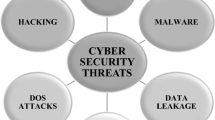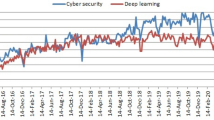Abstract
The variety and volume of cyber-attacks have exponentially increased over the years. This calls for a strong security defense mechanism against the attacks. This paper discusses the advancements made in the field of cyber-security using various machine learning techniques. We review some of the common machine learning techniques used in cyber-security and also discuss the issues related to cyber-security. Overall, we focus on exploring the idea of a combination of deep learning, machine learning and human supervision.
Access this chapter
Tax calculation will be finalised at checkout
Purchases are for personal use only
Similar content being viewed by others
References
Hatcher WG, Yu W (2018) A survey of deep learning: platforms, applications and emerging research trends. IEEE Access 6. https://doi.org/10.1109/ACCESS.2018.2830661
Mishra S, Tripathy HK, Mallick PK, Bhoi AK, Barsocchi P (2020) EAGA-MLP—an enhanced and adaptive hybrid classification model for diabetes diagnosis. Sensors 20(14):4036
Mallick PK, Mishra S, Chae GS (2020) Digital media news categorization using Bernoulli document model for web content convergence. Pers Ubiquit Comput. https://doi.org/10.1007/s00779-020-01461-9
Mishra S, Mallick PK, Jena L, Chae GS (2020) Optimization of skewed data using sampling-based preprocessing approach. Front Public Health 8:274. https://doi.org/10.3389/fpubh.2020.00274
Vinayakumar R, Alazab M (Senior Member, IEEE), Soman KP, Poornachandran P, AlNemrat A, Venkatraman AN (2019) Deep learning approach for intelligent intrusion detection system. IEEE Access 7. https://doi.org/10.1109/ACCESS.2019.2895334
Zahangir Alom M, Bontupalli VR, Taha TM (2015) Intrusion detection using deep belief networks. 978-1-4673-7565-8/15/$31.00 ©2015 IEEE
Shone N, Phai VD, Ngoc TN, Shi Q (2018) A deep learning approach to network intrusion detection. IEEE Trans Emerg Top Comput Intell 41–50, February 2018
Uppal D, Jain V, Sinha R, Mehra V. Malware detection and classification based on extraction of API sequences. 978-1-4799-3080-7/14/$31.00_c 2014 IEEE
Chowdhury M, Rahman A, Islam R (2017) Protecting data from malware threats using machine learning technique. In: 2017 12th IEEE conference on industrial electronics and applications (ICIEA)
Kalash M, Rochan M, Mohammed N, Bruce NDB, Wang Y, Iqbal F (2018) Malware classification with deep convolutional neural networks. 978-1-5386-3662-6/18/$31.00 ©2018 IEEE
Arp D, Spreitzenbarth M, Hubner M, Gascon H, Rieck K (2014) Drebin: efficient and explainable detection of android malware in your pocket. In: Proceedings of 20th annual network. distributed system security symposium (NDSS), San Diego, CA, USA, February 2014, pp 1–15
Varsha MV, Vinod P, Dhanya KA (2017) Identification of malicious Android app using manifest and opcode features. J Comput Virol Hacking Tech 13(2):125–138
Sharma A, Dash SK (2014) Mining API calls and permissions for Android malware detection. In: Cryptology and network security. Springer International, Cham, Switzerland, pp 191–205
Mishra M, Mishra S, Mishra BK, Choudhury P (2017) Analysis of power aware protocols and standards for critical E-health applications. In: Internet of Things and big data technologies for next generation healthcare. Springer, Cham, pp 281–305
Mishra S, Mahanty C, Dash S, Mishra BK (2019) Implementation of BFS-NB hybrid model in intrusion detection system. In: recent developments in machine learning and data analytics. Springer, Singapore, pp 167–175
Mishra S, Thakkar H, Chakrabarty A, Kimtani D (2012) Dynamic cluster based data aggregation in WSN (FDDA). Int J Electron Commun Comput Technol (IJECCT) 2(5):227–230
Mishra S, Mallick PK, Tripathy HK, Bhoi AK, González-Briones A (2020) Performance evaluation of a proposed machine learning model for chronic disease datasets using an integrated attribute evaluator and an improved decision tree classifier. Appl Sci 10(22):8137
Mishra S, Tripathy HK, Mishra BK (2018) Implementation of biologically motivated optimisation approach for tumour categorisation. Int J Comput Aided Eng Technol 10(3):244–256
Bhoi AK, Sherpa KS (2014) QRS complex detection and analysis of cardiovascular abnormalities: a review. Int J Bioautom 18(3):181–194
Bhoi AK, Sherpa KS, Khandelwal B (2018) Arrhythmia and ischemia classification and clustering using QRS-ST-T (QT) analysis of electrocardiogram. Clust Comput 21(1):1033–1044
Bhoi AK, Sherpa KS, Khandelwal B (2018) Ischemia and Arrhythmia classification using time-frequency domain features of QRS complex. Procedia Comput Sci 132:606–613
Bhoi AK, Sherpa KS (2016) Statistical analysis of QRS-complex to evaluate the QR versus RS interval alteration during ischemia. J Med Imaging Health Inform 6(1):210–214
Bhoi AK (2017) Classification and clustering of Parkinson’s and healthy control gait dynamics using LDA and K-means. Int J Bioautom 21(1)
Author information
Authors and Affiliations
Corresponding author
Editor information
Editors and Affiliations
Rights and permissions
Copyright information
© 2022 The Author(s), under exclusive license to Springer Nature Singapore Pte Ltd.
About this paper
Cite this paper
Sharma, A., Das, P.A., Ijaz, M.F., Rana, A.u.H.S. (2022). Machine Learning Capability in the Detection of Malicious Agents. In: Dhar, S., Mukhopadhyay, S.C., Sur, S.N., Liu, CM. (eds) Advances in Communication, Devices and Networking. Lecture Notes in Electrical Engineering, vol 776. Springer, Singapore. https://doi.org/10.1007/978-981-16-2911-2_26
Download citation
DOI: https://doi.org/10.1007/978-981-16-2911-2_26
Published:
Publisher Name: Springer, Singapore
Print ISBN: 978-981-16-2910-5
Online ISBN: 978-981-16-2911-2
eBook Packages: EngineeringEngineering (R0)




